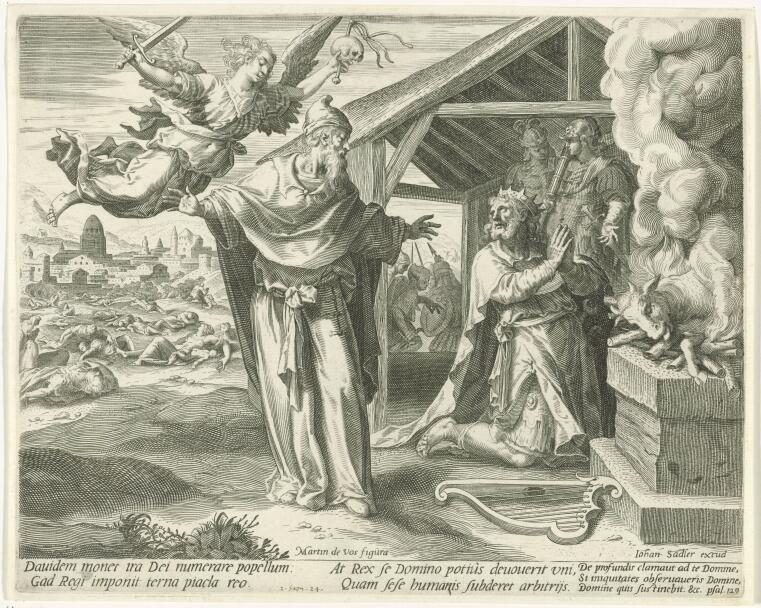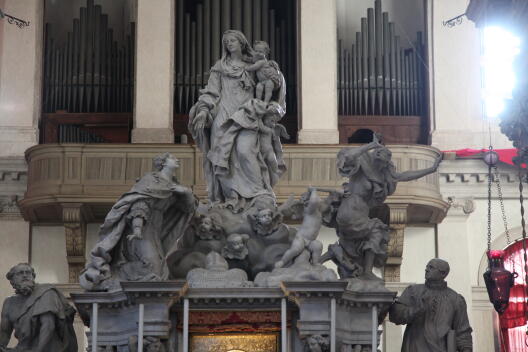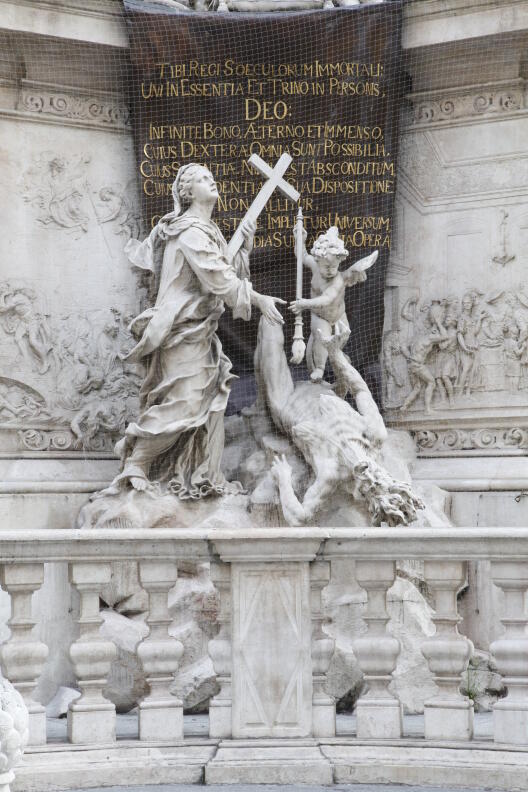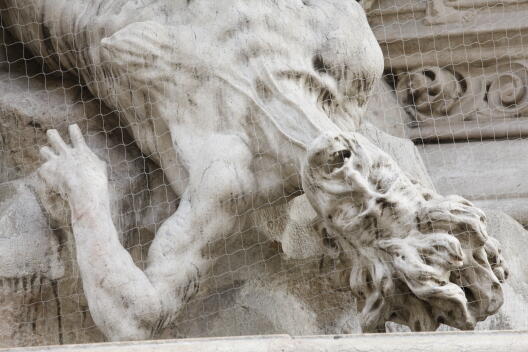“Angel of the Lord” and “Donna spauenteuole”: Depictions of the plague in early modern art
By art historian Jens Niebaum

The engraving shown here, which Aegidius Sadeler probably made around 1580-1600 after a model by the Antwerp painter Maerten de Vos as part of a cycle of scenes from the Old Testament published by his uncle Johann, presents in condensed form an episode from the 2nd Book of Samuel (24: 15-25) and the 1st Book of the Chronicles (21:14-27) that deals with a plague at the time of David. The prehistory is reported in the caption: David had sinned and, of three possible punishments that God gave him to choose from to atone through the prophet Gad, he had chosen “three days of the sword of the LORD – days of plague in the land” (1 Chronicles 21:12). The report cites an angel sent by God “to destroy Jerusalem” (21:14); the angel appears on the left above a field littered with corpses in front of the city in the background. It is also the angel who then orders David through Gad to build an altar of atonement “on the threshing floor of Araunah the Jebusite” (21:18). The prophet stands in the foreground, a little to the left of centre, and acts as a mediator between the angel and David, who has sunk down to the right in front of the threshing floor to offer “burnt offerings and fellowship offerings” on the altar (21:26); his own lines of lamentation from Psalms 129 (130):1,3 are placed in his mouth in the bottom right-hand corner of the painting. In the episode of the Atonement, God commanded the angel to “put his sword back into its sheath” (21:27), which of course is no longer depicted.
According to the Biblical text, the angel of the Lord held “a drawn sword in his hand extended over Jerusalem” (1 Chr. 21:16). Portrayed in the text as an active force fulfilling God’s will, the angel is also an index for the plague, which lasts as long as the angel stands with drawn sword “between heaven and earth”, between punitive God and suffering human. De Vos further underlines this function by furnishing the angel not only with a sword, but also with a whip with an implanted skull, attributes that are not mentioned in the Biblical text, but which were common symbols of death and punishment. The sword could also occasionally be replaced by plague arrows (see the contribution by Matthias Sandberg), for example in an engraving by Lucas van Leyden. Finally, the motif of the plague angel sheathing his sword to indicate the end of the plague also became widespread. The most famous example is the sculpture of the Archangel Michael on the Roman mausoleum of Hadrian, which was erected in 1577 to replace an existing mausoleum that had been erected in the 14th century at the latest, and which was in turn replaced in 1752 by the present one: it perpetuates an apparition given to Pope Gregory the Great in 590 over the ‘Castel Sant’Angelo’, which signalled the end of the plague that had been raging in Rome. In numerous paintings from the 17th and 18th centuries, the motif indicates the success of the intercession of saints in favour of plague-stricken cities or groups (see the dossier “(In)visibility”).

The angel is thus a symbol of the raging plague that goes back directly to a Biblical model. This is not the case with the image of the plague that appears on the high altar of the famous votive church of Santa Maria della Salute, praised by the Senate of the Republic of Venice. The sculptor Josse de Corte, who was born in Ypres, created a multi-part ensemble with a historical-allegorical core group: on the left, an allegory of Venice kneels in the doge’s robes with a contrasting headdress before Mary, who stands in the clouds on the crescent moon and, her child in her arms, appears as an intercessor. The success of request and intercession becomes visible on the other side of the painting: a putto pushes an allegory of the plague down from the podium with a burning torch, which, with a loud cry and arms raised defensively, tries to flee.

The actual theme of the painting is not the plague itself, but rather the ‘mechanism’ of making an intercession and being heard that, according to common perception, had brought about the end of the epidemic. How, then, did the painter make these processes, which are so difficult to visualize, visible? First of all, he clearly marks the categorical otherness of the heavenly and earthly spheres. Even the clouds unmistakably mark the constitutive break in reality, which is emphatically reinforced by the colouring of the figures: Christ and the avenging angel become, as it were, light-suffused apparitions before or at the height of the divine light, while the intercessors Mary and Januarius, located on a middle level between divine and earthly figures, appear in comparatively strong colours. Under their clouds, on the other hand, the dead are clearly shrouded in deep shadows. In only a superficially paradoxical way, the earthly dead are dematerialized, as it were, while the immaterial in the heavenly sphere are substantiated, and thus made visible as the protagonists of the actual event.
The plague is portrayed as an old woman with grotesquely distorted features, wrinkled skin, and a tattered robe that exposes her sagging, dried-out breast. As we know, de Corte based his work on the two proposals for an allegory of the plague made by the Perugian scholar Cesare Ripa (c. 1555-1622) in the Iconologia, his famous collection of personifications of abstract terms, first published in 1593. The allegory is imagined as an “old, gaunt, and frightening woman” (“Donna vecchia, macilenta, & spauenteuole”) sitting on animal skins and holding with bloody wounds in her hand a whip; there is also mention of a “pale, frightening face”, naked arms, torn clothes, and “misshapen” breasts. Why these (and similar) attributes? According to Ripa: “Just as this figure is gaunt, ugly to look at because of its age and colour, so the plague is terrible and awful because of its eerie and gloomy overall appearance”. Thus, the ugliness of the manifestations that can be perceived by the senses constitutes the common factor justifying the suitability of the figurative sign for the signified (see also the contribution by Martina Wagner-Egelhaaf in this dossier). The symbol of the plague is therefore founded here not on the Bible, but aesthetically – and, in de Corte’s case, it is particularly enhanced by the contrast with the radiant beauty of Mary, but also with the allegory of Venice. This also makes clear, then, the close intertwining of aesthetic and ethical-religious points of view.
The plague also appears as an old woman in an allegory by the Viennese court sculptor Paul Strudel, created around 1690/92 and placed at the base of the Holy Trinity Column, the famous monument to the plague at the Graben in Vienna, which was praised by Emperor Leopold I during the devastating plague of 1679 and erected in 1680-92 (see the dossier “Space”). Completely naked and plunged headfirst to the ground, she desperately tries to fend off the cherub standing above her, who strikes her with a burning torch. The attributes of ugliness are even more acute here: the wrinkles under the fury-like lambent hair dig deep into the skin of her face, from the open mouth only a few teeth stick out, the décolleté and sagging breasts are crossed with sinews and veins.


It is well known that the allegorical embodiment of the plague is combined here with features that were common in the depiction of heresy, and in this context also belongs the fact that an allegory of faith or religion, depicted as a young and again emphatically beautiful woman with the cross in her hand, stands upright beside the fallen plague, confirming its fall. It was common to link the plague closely to “heresy” and “unbelief”; reference was made to a statement by the Jesuit Petrus Canisius, who described “the heretics and schismatics as a harmful pestilence” (C. Boeckl). Here, too, we can see very clearly the plague’s connectibility to other discourses (see the contribution by Martina Wagner-Egelhaaf) – in this case, as a means to discredit other denominations and religions by drastically reducing them to a deadly plague.
When the current US President consistently refers to Covid-19 as the “China virus”, then comparable mechanisms still seem to play a role regarding the question of the source of the pandemic.

